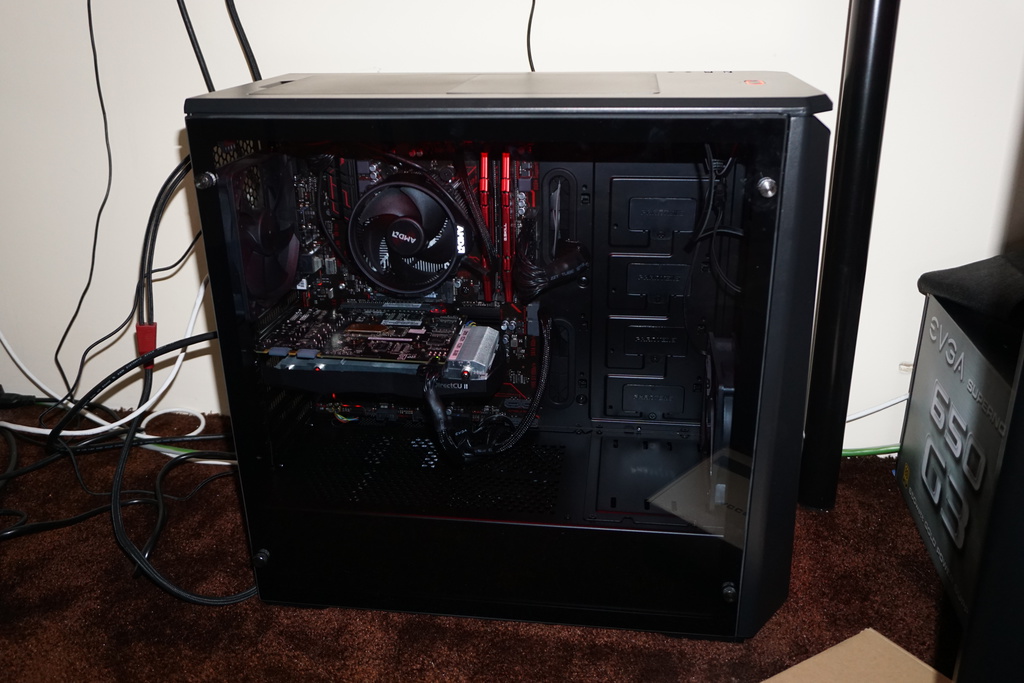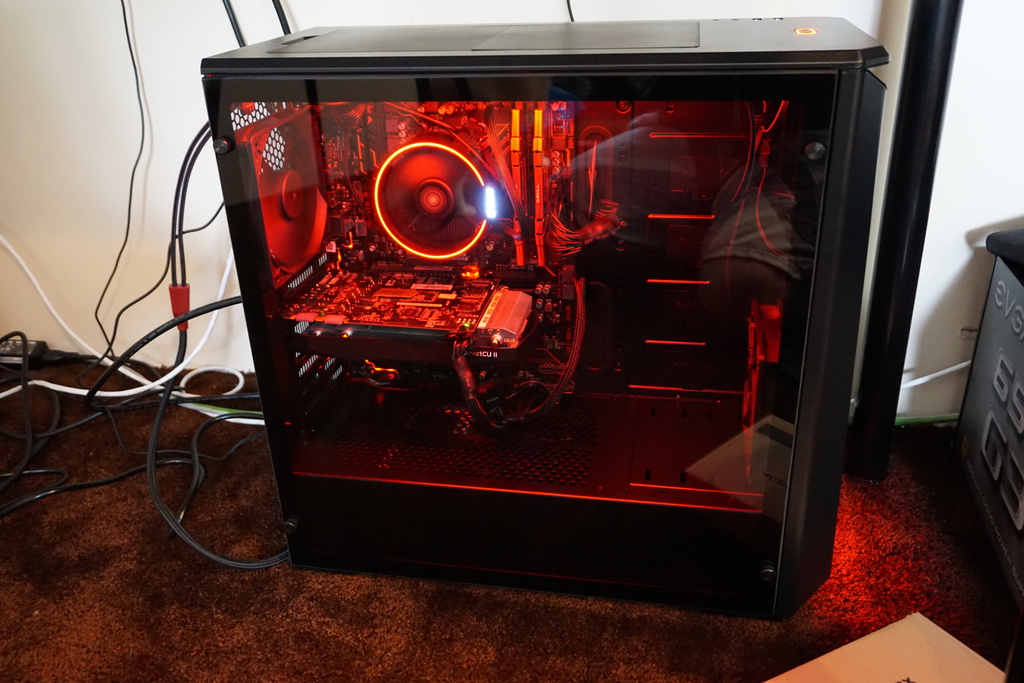Some enthusiasts may want to have another look at the product placement of the Ryzen CPUs, because there are arguments which continue to be brought up that seem to be in direct opposition to that.
If it's a misunderstanding or misinterpretation of AMD's marketing, that's fine (particularly given some of their challenges on that front, or ill-advised decisions they have made in certain areas).
If it's a matter of being willfully ignorant of the actual product stack at it relates to competition, then they would be doing a disservice to others who may be less technically inclined and are simply looking for honest assessments of the parts being discussed.
The notion that Ryzen 7s are particularly expensive is puzzling, as it seems to ignore the 6c/12t and 8c/16t Intel parts they're primarily targeted at, along with the overall platform costs. Quite simply, if people have not made such arguments against the 5960X, 6900K and the like in comparison to Devil's Canyon, Skylake and Kaby Lake, I fail to see how most of those same arguments can now be made against the R7s. That's even taking into consideration the immature state of software and hardware support.
The comparison of the 7700K to the 1700, while logical in many regards, is still faulty. Although similarly priced and shown in AMD's own materials, notice how the productivity and multi-tasking angle of the 1700 was often highlighted, even more so than the 2 higher-end models. The other two seem to have a greater focus on gaming material from AMD as they are closer in clock speeds, IPC, and cores to their Intel counterparts. The company showed their fair share of 7700K vs 1700 gaming benches, but how often did they describe it as beating the top Kaby Lake/DC/Sky 4c/8t parts in gaming? As far as I can tell, that AMD-made comparison is mostly born from the price points, and potential conquest sales for those who do more than game and could benefit from the increased threads, over the increased frames the higher clocked 4-cores would provide in games that benefit from IPS the most.
Haswell-E/Broadwell-like IPC is nice, though no informed person would have you believe that alone can overcome higher stock clocks in the the instances where moderately-threaded IPS makes the most difference.
Notice how often streaming, productivity and multi-tasking is brought up by AMD when the 1700 was shown alongside the 4-cores (and a few instances of it being compared to the "entry level" 6-cores).

In other news...
I've had an 8c/16t Intel build for a while. It's fast, games well and chews up most everything I throw at it.
I've had an 8c/16t AMD build since NDA lifted. It's fast, games well and chews up most everything I throw at it.
The two systems have matching cases and run quiet under air cooling, though I may slap a 360 rad on the Ryzen shortly. I'd be interested in knowing how Windows Task Manager displays the cores/threads arrangement and whether I'm misunderstanding it, or it may change when Windows is patched for Ryzen.
As is, the Intel generally spreads the loads as you'd expect across all 16 threads. Unless I'm very mistaken the AMD seems to be using 4 cores primarily, and then generating additional threads across on those same the 4 main core's logical threads. So in effect using SMT before the remaining physical cores have been used.
Even in un-patched OS form I'm going to assume it's likely due to the CCX configuration and may be an error on my part... Again, I'm busy and haven't had a great deal of time to test multiple games and apps to observe this further. I don't know if any reviews or owners have mentioned this, it simply looks different in how it scales from ~4-16 threads. *shrug*
Random thoughts:
- The photo above is the Cooler Master Hyper 212 AM4 kit I have, along with the AM4 kit for my Phanteks PH-TC14PE dual tower HSF (notice the dual notches in the bracket for AM3+ use as well).
- I've changed nearly nothing in the BIOS. The system turbos into 4.1GHz XFR on its own. Chooses a core, then hits 4.1GHz. By far, it's more likely to hit XFR range on a given core than it is to hit the normal 4GHz max turbo.
- Clean Win 10 install which I haven't yet set to the recommended "High Performance" profile along with CCX possibly confusing Windows (or this user), the usage I mentioned above could simply be due to core-parking.
- Noctua have sent my AM4 kit for my NH-D15. If I ever get around to it (**doubtful**) I may do some comparisons against the Phanteks since results between the two can vary depending on what kind of die each one is cooling.
- Cryorig told me their kit is not complete, but they'll send it to me once it's available. Currently cooling that Intel rig mentioned above anyway.
- I'd say average all core turbo would be ~3.7GHz. but I need to look into that further.
- As a general rule, we'd all do well spending less time fighting pro or against random tech companies who are not our friends, and simply enjoying products. I usually have at least 1 CPU and GPU from each vendor, plus the 3 main consoles. It's better that way (for me) and not all that expensive depending on your circumstances.
If it's a misunderstanding or misinterpretation of AMD's marketing, that's fine (particularly given some of their challenges on that front, or ill-advised decisions they have made in certain areas).
If it's a matter of being willfully ignorant of the actual product stack at it relates to competition, then they would be doing a disservice to others who may be less technically inclined and are simply looking for honest assessments of the parts being discussed.
The notion that Ryzen 7s are particularly expensive is puzzling, as it seems to ignore the 6c/12t and 8c/16t Intel parts they're primarily targeted at, along with the overall platform costs. Quite simply, if people have not made such arguments against the 5960X, 6900K and the like in comparison to Devil's Canyon, Skylake and Kaby Lake, I fail to see how most of those same arguments can now be made against the R7s. That's even taking into consideration the immature state of software and hardware support.
The comparison of the 7700K to the 1700, while logical in many regards, is still faulty. Although similarly priced and shown in AMD's own materials, notice how the productivity and multi-tasking angle of the 1700 was often highlighted, even more so than the 2 higher-end models. The other two seem to have a greater focus on gaming material from AMD as they are closer in clock speeds, IPC, and cores to their Intel counterparts. The company showed their fair share of 7700K vs 1700 gaming benches, but how often did they describe it as beating the top Kaby Lake/DC/Sky 4c/8t parts in gaming? As far as I can tell, that AMD-made comparison is mostly born from the price points, and potential conquest sales for those who do more than game and could benefit from the increased threads, over the increased frames the higher clocked 4-cores would provide in games that benefit from IPS the most.
Haswell-E/Broadwell-like IPC is nice, though no informed person would have you believe that alone can overcome higher stock clocks in the the instances where moderately-threaded IPS makes the most difference.
Notice how often streaming, productivity and multi-tasking is brought up by AMD when the 1700 was shown alongside the 4-cores (and a few instances of it being compared to the "entry level" 6-cores).

In other news...
I've had an 8c/16t Intel build for a while. It's fast, games well and chews up most everything I throw at it.
I've had an 8c/16t AMD build since NDA lifted. It's fast, games well and chews up most everything I throw at it.
The two systems have matching cases and run quiet under air cooling, though I may slap a 360 rad on the Ryzen shortly. I'd be interested in knowing how Windows Task Manager displays the cores/threads arrangement and whether I'm misunderstanding it, or it may change when Windows is patched for Ryzen.
As is, the Intel generally spreads the loads as you'd expect across all 16 threads. Unless I'm very mistaken the AMD seems to be using 4 cores primarily, and then generating additional threads across on those same the 4 main core's logical threads. So in effect using SMT before the remaining physical cores have been used.
Even in un-patched OS form I'm going to assume it's likely due to the CCX configuration and may be an error on my part... Again, I'm busy and haven't had a great deal of time to test multiple games and apps to observe this further. I don't know if any reviews or owners have mentioned this, it simply looks different in how it scales from ~4-16 threads. *shrug*
Random thoughts:
- The photo above is the Cooler Master Hyper 212 AM4 kit I have, along with the AM4 kit for my Phanteks PH-TC14PE dual tower HSF (notice the dual notches in the bracket for AM3+ use as well).
- I've changed nearly nothing in the BIOS. The system turbos into 4.1GHz XFR on its own. Chooses a core, then hits 4.1GHz. By far, it's more likely to hit XFR range on a given core than it is to hit the normal 4GHz max turbo.
- Clean Win 10 install which I haven't yet set to the recommended "High Performance" profile along with CCX possibly confusing Windows (or this user), the usage I mentioned above could simply be due to core-parking.
- Noctua have sent my AM4 kit for my NH-D15. If I ever get around to it (**doubtful**) I may do some comparisons against the Phanteks since results between the two can vary depending on what kind of die each one is cooling.
- Cryorig told me their kit is not complete, but they'll send it to me once it's available. Currently cooling that Intel rig mentioned above anyway.
- I'd say average all core turbo would be ~3.7GHz. but I need to look into that further.
- As a general rule, we'd all do well spending less time fighting pro or against random tech companies who are not our friends, and simply enjoying products. I usually have at least 1 CPU and GPU from each vendor, plus the 3 main consoles. It's better that way (for me) and not all that expensive depending on your circumstances.






